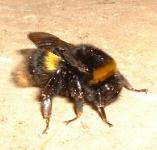Bumble Bees

The Bumble Bee is the largest species of bee found in the British Isles. There are about 19 species which can be identified from markings, mouth parts and body size, eg. the Bombus terrestris queen has orangy-yellow hairs at the end of its abdomen, whereas B. lucorum has lemon-yellow hairs (worker bees of both species have identical white hairs and are difficult to tell apart).
They live in colonies of up to 150, but only fertilised young queens survive the winter as they do not make enough honey to see them through the cold season. Their ability to sting is of concern to most people, but they are not as aggressive as honey-bees and the drones (males) do not have a sting at all. They will only sting under if duress, but do not lose the sting and die if they do, the same as Honeybees.In March as the weather warms up the queen emerges to start a new colony in a vacant mouse nest or a dry hedgerow bank. She lays about six eggs in a ball of nectar and wax, adding to it as the hatched grubs feed and grow. These emerge as workers (females) a few days later, they begin to collect pollen and nectar to feed the grubs of the eggs the queen continues to lay. At the height of summer the nest is about 120mm in diameter and the queen begins to lay eggs which will become drones and new queens for the next year. The drones leave the nest to live independantly while looking for a queen to fertilize. At the first frosts the old queen, workers and drones are killed, only the fertilised new queens find a sheltered spot to hibernate.
Bumble-bees require a supply of pollen and nectar from spring to autumn so a succession of flowering plants in the garden will help them through their year. Primulas, heathers and flowering currant make an early supply. They perfer a warm south-facing, shelterd spot to nest; a clump of twigs and dry leaves or an upturned pot with dry hay or straw in it would provide suitable shelter. An old teapot, burried with the spout exposed in a downward position, is one way to provide a nesting site.
For hibernation a dry, north-facing position is best as an early sunny day may encourage the queen to emerge too soon, only to be killed by the frost.

0 Comments:
Post a Comment
<< Home